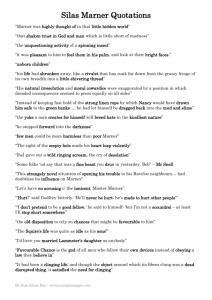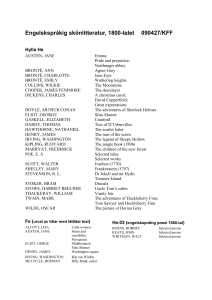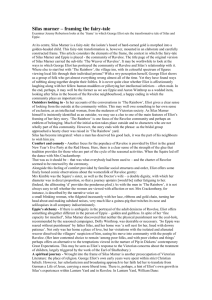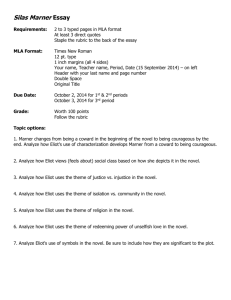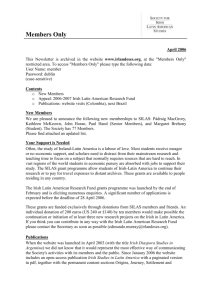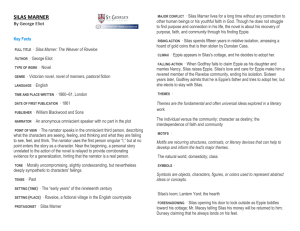General
advertisement
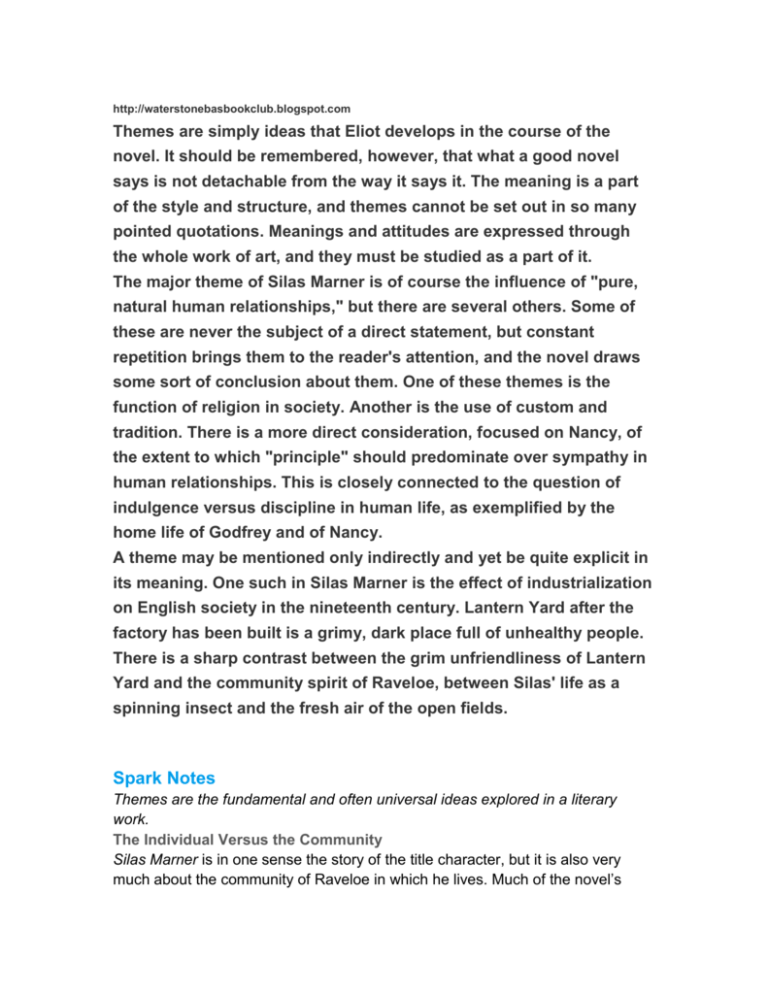
http://waterstonebasbookclub.blogspot.com Themes are simply ideas that Eliot develops in the course of the novel. It should be remembered, however, that what a good novel says is not detachable from the way it says it. The meaning is a part of the style and structure, and themes cannot be set out in so many pointed quotations. Meanings and attitudes are expressed through the whole work of art, and they must be studied as a part of it. The major theme of Silas Marner is of course the influence of "pure, natural human relationships," but there are several others. Some of these are never the subject of a direct statement, but constant repetition brings them to the reader's attention, and the novel draws some sort of conclusion about them. One of these themes is the function of religion in society. Another is the use of custom and tradition. There is a more direct consideration, focused on Nancy, of the extent to which "principle" should predominate over sympathy in human relationships. This is closely connected to the question of indulgence versus discipline in human life, as exemplified by the home life of Godfrey and of Nancy. A theme may be mentioned only indirectly and yet be quite explicit in its meaning. One such in Silas Marner is the effect of industrialization on English society in the nineteenth century. Lantern Yard after the factory has been built is a grimy, dark place full of unhealthy people. There is a sharp contrast between the grim unfriendliness of Lantern Yard and the community spirit of Raveloe, between Silas' life as a spinning insect and the fresh air of the open fields. Spark Notes Themes are the fundamental and often universal ideas explored in a literary work. The Individual Versus the Community Silas Marner is in one sense the story of the title character, but it is also very much about the community of Raveloe in which he lives. Much of the novel’s dramatic force is generated by the tension between Silas and the society of Raveloe. Silas, who goes from being a member of a tight-knit community to utterly alone and then back again, is a perfect vehicle for Eliot to explore the relationship between the individual and the surrounding community. In the early nineteenth century, a person’s village or town was all-important, providing the sole source of material and emotional support. The notion of interconnectedness and support within a village runs through the novel, in such examples as the parish’s charitable allowance for the crippled, the donation of leftovers from the Squire’s feasts to the village’s poor, and the villagers who drop by Silas’s cottage after he is robbed. The community also provides its members with a structured sense of identity. We see this sense of identity play out in Raveloe’s public gatherings. At both the Rainbow and the Squire’s dance, interaction is ritualized through a shared understanding of each person’s social class and place in the community. As an outsider, living apart from this social structure, Silas initially lacks any sense of this identity. Not able to understand Silas in the context of their community, the villagers see him as strange, regarding him with a mixture of fear and curiosity. Silas is compared to an apparition both when he shows up at the Rainbow and the Red House. To be outside the community is to be something unnatural, even otherworldly. Though it takes fifteen years, the influence of the community of Raveloe does eventually seep into Silas’s life. It does so via Godfrey’s problems, which find their way into Silas’s cottage first in the form of Dunsey, then again in Eppie. Eliot suggests that the interconnectedness of community is not something one necessarily enters into voluntarily, nor something one can even avoid. In terms of social standing, Silas and Godfrey are quite far from each other: whereas Silas is a distrusted outsider, Godfrey is the village’s golden boy, the heir of its most prominent family. By braiding together the fates of these two characters and showing how the rest of the village becomes implicated as well, Eliot portrays the bonds of community at their most inescapable and pervasive. Character as Destiny The plot of Silas Marner seems mechanistic at times, as Eliot takes care to give each character his or her just deserts. Dunsey dies, the Squire’s lands are divided Godfrey wins Nancy but ends up childless, and Silas lives happily ever after with Eppie as the most admired man in Raveloe. The tidiness of the novel’s resolution may or may not be entirely believable, but it is a central part of Eliot’s goal to present the universe as morally ordered. Fate, in the sense of a higher power rewarding and punishing each character’s actions, is a central theme of the novel. For Eliot, who we are determines not only what we do, but also what is done to us. Nearly any character in the novel could serve as an example of this moral order, but perhaps the best illustration is Godfrey. Godfrey usually means well, but is unwilling to make sacrifices for what he knows to be right. At one point Godfrey finds himself actually hoping that Molly will die, as his constant hemming and hawing have backed him into so tight a corner that his thoughts have become truly horrible and cruel. However, throughout the novel Eliot maintains that Godfrey is not a bad person—he has simply been compromised by his inaction. Fittingly, Godfrey ends up with a similarly compromised destiny: in his marriage to Nancy he gets what he wants, only to eventually reach the dissatisfied conclusion that it is not what he wanted after all. Godfrey ends up in this ironic situation not simply because he is deserving, but because compromised thoughts and actions cannot, in the moral universe of Eliot’s novel, have anything but compromised results. The Interdependence of Faith and Community In one sense Silas Marner can be seen simply as the story of Silas’s loss and regaining of his faith. But one could just as easily describe the novel as the story of Silas’s rejection and subsequent embrace of his community. In the novel, these notions of faith and community are closely linked. They are both human necessities, and they both feed off of each other. The community of Lantern Yard is united by religious faith, and Raveloe is likewise introduced as a place in which people share the same set of superstitious beliefs. In the typical English village, the church functioned as the predominant social organization. Thus, when Silas loses his faith, he is isolated from any sort of larger community. The connection between faith and community lies in Eliot’s close association of faith in a higher authority with faith in one’s fellow man. Silas’s regained faith differs from his former Lantern Yard faith in significant ways. His former faith was based first and foremost on the idea of God. When he is unjustly charged with murder, he does nothing to defend himself, trusting in a just God to clear his name. The faith Silas regains through Eppie is different in that it is not even explicitly Christian. Silas does not mention God in the same way he did in Lantern Yard, but bases his faith on the strength of his and Eppie’s commitment to each other. In his words, “since . . . I’ve come to love her . . . I’ve had light enough to trusten by; and now she says she’ll never leave me, I think I shall trusten till I die.” Silas’s new faith is a religion that one might imagine Eliot herself espousing after her own break with formalized Christianity. It is a more personal faith than that of Lantern Yard, in which people zealously and superstitiously ascribe supernatural causes to events with straightforward causes, such as Silas’s fits. In a sense, Silas’s new belief is the opposite of his earlier, simplistic world view in that it preserves the place of mystery and ambiguity. Rather than functioning merely as a supernatural scapegoat, Silas’s faith comforts him in the face of the things that do not make sense to him. Additionally, as Dolly points out, Silas’s is a faith based on helping others and trusting others to do the same. Both Dolly’s and especially Silas’s faith consists of a belief in the goodness of other people as much as an idea of the divine. Such a faith is thus inextricably linked to the bonds of community.

